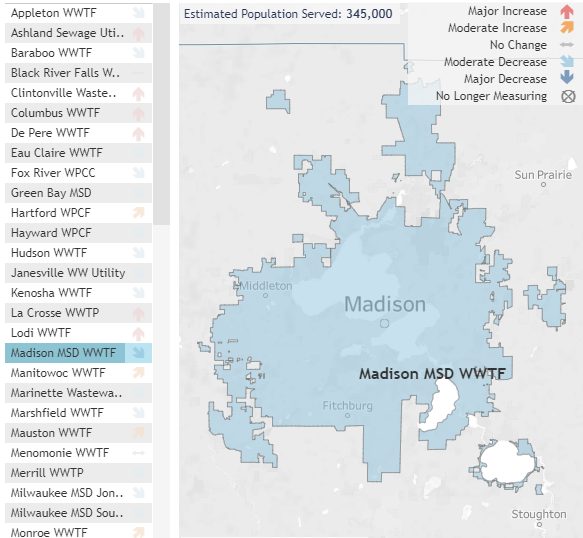
Did you know that testing wastewater can detect new variants and trends in COVID-19 outbreaks? It’s true. Wisconsin has a COVID-19 monitoring network that analyzes and reports on levels of coronavirus in wastewater by city, region or sewershed (e.g., our District) via a helpful dashboard.
Wisconsin’s COVID-19 Wastewater Monitoring Network offers the following information:
- Community increases or decreases in COVID-19
- Levels of COVID-19 in wastewater
- Average COVID-19 case rate, by area
- Estimated population served by the facility or district
- Approximate boundaries of the service area (map)
Wastewater Provides early detection
We can obtain trending data that informs and protects public health by analyzing wastewater over time. RNA from Sars-CoV-2 (the virus that causes COVID-19) can be found in fecal matter shortly after an infection, sometimes days before an infected person shows symptoms or takes a COVID test. Increases in RNA in wastewater at the community level can be observed up to a week before corresponding increases in community case numbers (obtained through clinical diagnoses) begin to trend.
Wastewater offers pooled sampling
When sewage reaches the wastewater treatment plant, it is an aggregate and well-mixed sample from many homes and businesses. By sampling the influent at the plant, the project can have a representative snapshot of the whole community vs. testing every person individually. Also, many people that contract the virus have very mild or no symptoms, which reduces their likelihood of clinical testing or being identified as carriers of COVID-19. The pooled sample captures people who may not go in for testing and provides a more complete picture of coronavirus trends in the community.
Limitations of wastewater testing
How long and how much of the virus is shed in fecal matter is unclear. It is estimated that people can have the virus in their feces for 20 to 30 days after they are no longer contagious, so decreases in virus trends might lag behind results from clinical testing. Also, as people travel in and out of a sewershed for work or tourism, the people contributing to the community sample might vary. As a result, we should look at both sets of data — RNA in wastewater and community case numbers — as presented side-by-side in the dashboard.
Participants in the COVID-19 MONITORING project
The Wastewater Monitoring Network is a collaborative project between the Wisconsin Department of Health Services, Wisconsin State Lab of Hygiene and the University of Wisconsin-Milwaukee School of Freshwater Sciences. However, many different entities across the state contribute to making the COVID-19 monitoring project happen. At the time of publishing, over 45 sewerage districts, treatment facilities, treatment plants and local utilities in large and small cities across Wisconsin participate in the project, including Madison Metropolitan Sewerage District.
“It is our responsibility — as a District that serves 26 communities in Dane County — to do everything we can to help during the pandemic,” said Martin Griffin, director of ecosystem services at the District. “By partnering with the State Lab of Hygiene, Department of Health Services and the University of Wisconsin, we can advance the science around wastewater epidemiology that will normalize the way we use wastewater monitoring in the future.”
For the District to participate in collecting wastewater samples for surveillance, we had some initial logistics to work out. Twenty samples, collected over five days per week , are processed and packaged for the COVID-19 monitoring study and shipped to an external lab for analysis. To accommodate the additional volume required for this project, we adjusted our sample collection capacity in our autosamplers. We also found that having a set sampling schedule made it easier to plan and integrate the additional effort into our existing work.
Article written by Amy Steger






